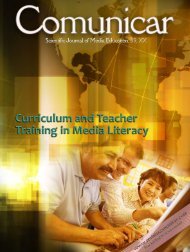Comunicar 39 - Revista Comunicar
Comunicar 39 - Revista Comunicar
Comunicar 39 - Revista Comunicar
Create successful ePaper yourself
Turn your PDF publications into a flip-book with our unique Google optimized e-Paper software.
INVESTIGACIONES / RESEARCH<br />
l Antonio Bautista, Laura Rayón y Ana de las Heras<br />
Madrid (España)<br />
Recibido: 29-02-2012 / Revisado: 21-03-2012<br />
Aceptado: 03-04-2012 / Publicado: 01-10-2012<br />
DOI: 10.<strong>39</strong>16/C<strong>39</strong>-2012-03-07<br />
Valor de los registros audiovisuales en<br />
educación intercultural<br />
Value of Audiovisual Records in Intercultural Education<br />
RESUMEN<br />
Este artículo analiza las posibilidades de los registros audiovisuales como datos en la investigación sobre relaciones<br />
interculturales, o aquellas que van dirigidas al conocimiento del otro. Pretende contribuir a la teorización sobre el<br />
valor de las narraciones fotográficas y videográficas en la representación y análisis de realidades de la enseñanza que<br />
son difíciles de captar y cuantificar. Concretamente, estudiamos si el registro audiovisual es una buena herramienta<br />
para recoger y analizar información situada sobre las intenciones e interpretaciones contenidas en las relaciones<br />
humanas. Después de presentar algunos dilemas epistemológicos y metodológicos, como la denominada crisis de la<br />
representación en ciencias sociales o el conflicto «etic-emic», y de plantear algunas soluciones dadas desde la antropología<br />
audiovisual, analizamos la naturaleza de algunas situaciones de educación intercultural recogidas en los dos<br />
colegios –etnografías– que soportan el estudio finalizado en 2011 y financiado por el Ministerio de Ciencia e<br />
Innovación de España, sobre el uso de narraciones audiovisuales como sustrato de las relaciones entre el alumnado<br />
diverso culturalmente de educación infantil y primaria. A modo de ejemplo, describimos cómo hemos llegado a algunas<br />
de las categorías o constructos que llevan a entender el universo de significados que dan sentido a la vez que<br />
condicionan y configuran las relaciones interculturales de esos centros. Finalmente, describimos las aportaciones de<br />
algunas herramientas del software NVivo 9 en el análisis del contenido de registros y narraciones foto-videográficas.<br />
ABSTRACT<br />
This article discusses the possibilities of audiovisual records as research data in intercultural relationships, or those<br />
that allow us to understand the Other. The research aims to contribute to the theory that is being developed on the<br />
nature and value of narratives in photographic and video representation and analysis of basic realities of teaching that<br />
are difficult to capture and quantify. Specifically, we examine whether audiovisual recording is a good tool for ga -<br />
thering and analysing information about intentions and interpretations contained in human relationships and practices.<br />
After presenting some epistemological and methodological dilemmas such as the crisis of representation in the<br />
social sciences or the «etic-emic» conflict and proposing some solutions taken from audiovisual anthropology, we<br />
analyse the nature of intercultural relationships in two schools –ethnographies– that support the study completed in<br />
2011 and funded by the Spanish Ministry of Science and Innovation: the use of visual narratives as a substrate of<br />
intercultural relationships between culturally diverse kindergarten and primary education pupils. As an example, we<br />
describe how we discovered some categories that allow us to understand the universe of meanings that make sense<br />
of, determine and shape their cultural relations. Finally, we describe the contributions of NVivo 9, a software package<br />
that facilitates the analysis of photo and video recordings and narratives.<br />
PALABRAS CLAVE / KEYWORDS<br />
Educación intercultural, antropología audiovisual, estudio de casos, narrativa audiovisual, aprendizaje colaborativo,<br />
registros audiovisuales.<br />
Intercultural education, audiovisual anthropology, case study, audiovisual narratives, collaborative learning, audiovisual<br />
recordings.<br />
v Dr. Antonio Bautista García-Vera es Catedrático del Departamento de Didáctica y Organización Escolar<br />
de la Universidad Complutense de Madrid (España) (bautista@edu.ucm.es).<br />
v Dra. Laura Rayón-Rumayor es Profesora Titular del Departamento de Didáctica de la Universidad de Alcalá<br />
de Henares en Madrid (España) (laura.rayon@uah.es).<br />
v Ana María de-las-Heras-Cuenca es Becaria FPI del Departamento de Didáctica y Organización Escolar<br />
de la Universidad Complutense de Madrid (España) (delasheras@edu.ucm.es).<br />
<strong>Comunicar</strong>, nº <strong>39</strong>, v. XX, 2012, <strong>Revista</strong> Científica de Educomunicación; ISSN: 1134-3478; páginas 169-176<br />
ww.revistacomunicar.com

















